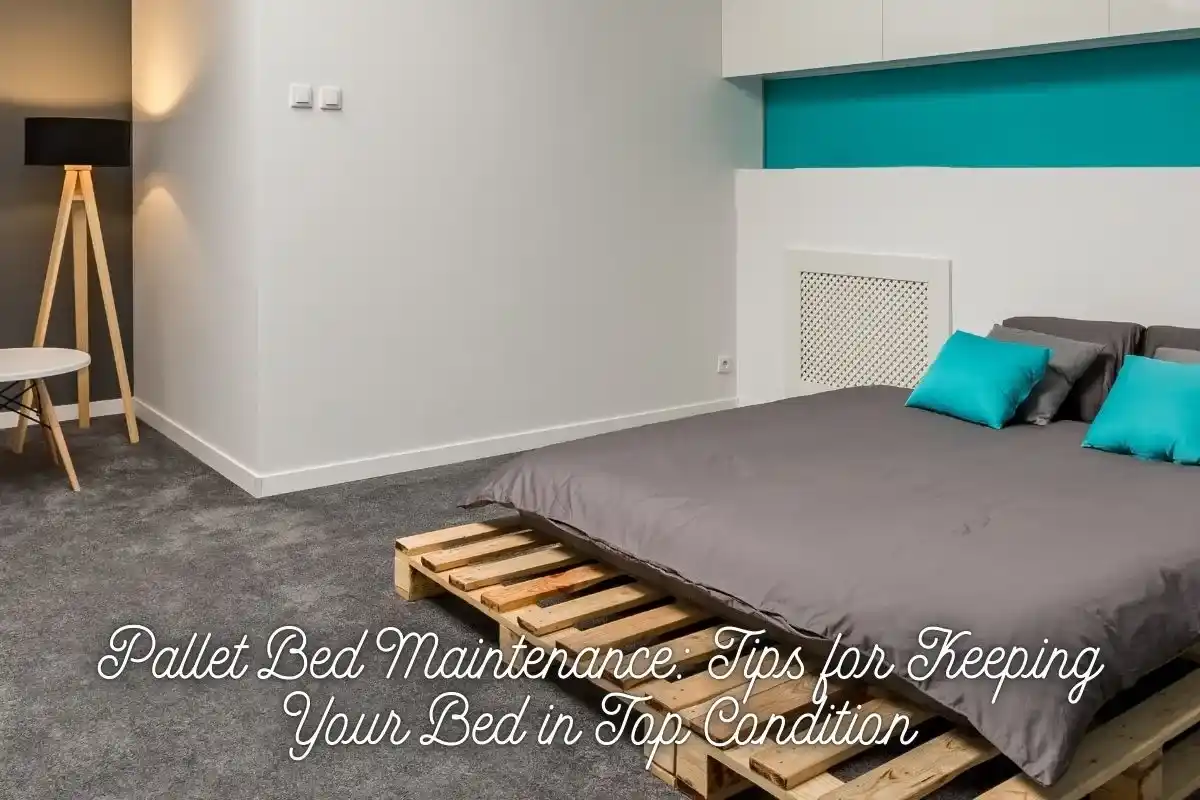Pallet beds have become a popular choice for many people looking to add a touch of rustic charm to their bedrooms. Not only are these beds stylish and versatile, but they are also a sustainable way to repurpose materials. However, like any piece of furniture, pallet beds require regular maintenance to stay in good condition.
Whether you’ve built your own pallet bed or bought one from a store, it’s important to maintain it to ensure that it lasts for years. From regular cleaning to protecting the wood from moisture and pests, maintaining your pallet bed might seem like a lot of work, but with the right approach, it’s easy to keep your bed looking great and functional. In this article, we’ll cover essential tips for keeping your pallet bed in top condition, as well as insights from experts who know a thing or two about furniture maintenance.
Table of Contents
ToggleThe Importance of Pallet Bed Maintenance
Before we dive into the specifics of maintaining your pallet bed, let’s take a moment to understand why it’s important to keep it in good shape.
Pallets are often made from recycled wood, which can be more susceptible to wear and tear than furniture made from newer, specially treated wood. Additionally, pallet beds are usually exposed to moisture, dust, and daily wear, which can lead to damage over time if not properly cared for.
As Bob Vila, a well-known TV host and contractor, says, “Proper maintenance is key to extending the lifespan of any piece of furniture, including pallet beds.” Regular care helps to prevent issues like splinters, sagging, and discoloration. It also ensures that your bed remains a safe, comfortable place to rest each night.
Essential Pallet Bed Maintenance Tips
1. Regular Cleaning
Keeping your pallet bed clean is one of the simplest and most effective ways to ensure its longevity. Dust, dirt, and grime can accumulate on the surface of the wood over time, which can dull its natural beauty. Regular cleaning also helps prevent allergens like dust mites from building up, which is especially important for those with allergies.
How to Clean:
- Use a soft cloth or microfiber duster to gently wipe down the surface of the bed frame.
- For deeper cleaning, use a mild cleaning solution mixed with water (avoid harsh chemicals that might damage the wood).
- If you notice any sticky residue, use a damp cloth to wipe it away, and then dry the area thoroughly.
Cleaning your pallet bed also gives you a chance to inspect it for any issues like splinters or cracks that might need attention.
2. Protect from Moisture
Moisture is one of the biggest enemies of wooden furniture. It can cause wood to warp, crack, or even rot if not properly managed. Since pallet beds are made from wood, protecting them from moisture is crucial for preserving their condition.
Tips for Protecting Your Pallet Bed from Moisture:
- Use a waterproof mattress protector. This can help shield the wood from spills, sweat, or humidity that may seep into the bed frame.
- Consider placing your bed on risers. This will improve airflow underneath the bed, reducing the risk of moisture buildup.
- If you live in a humid environment, it may be helpful to use a dehumidifier in your room to reduce the overall moisture in the air.
As Martha Stewart, a household name in home and design, advises, “Regular cleaning and protection will help your pallet bed maintain its rustic charm and withstand the test of time.”
3. Inspect for Signs of Wear and Tear
Wooden furniture naturally experiences wear and tear over time, especially if it’s used regularly. Pallet beds, being constructed from reclaimed materials, may be more vulnerable to damage like loose boards, cracks, or splinters. To keep your bed in good shape, it’s important to inspect it regularly for signs of wear.
What to Look for:
- Loose boards or nails: These can pose a safety hazard and also affect the stability of the bed.
- Splinters or rough edges: These can cause discomfort or even injury.
- Pest infestation: Wood can attract pests like termites or woodlice, so be sure to look for any signs of infestation.
If you notice any of these issues, it’s best to address them promptly to prevent further damage.
4. Refinish as Needed
Over time, the finish on your pallet bed might fade or wear off due to regular use. Refinishing your bed is a great way to restore its beauty and protect the wood from further damage.
You can re-stain or repaint your pallet bed depending on your preferred look. If you want to maintain the natural rustic charm, a clear wood finish can enhance the wood grain while offering protection. If you prefer a different color, you can paint the bed to match your bedroom decor.
How to Refinish Your Pallet Bed:
- Sand the surface lightly to remove any rough spots or peeling paint.
- Apply a wood stain or paint using a brush or rag. Make sure to follow the product’s instructions for best results.
- Once the finish is dry, apply a protective coat (like polyurethane) to lock in the color and protect the wood from further damage.
As interior designer Nate Berkus suggests, “Embrace the natural beauty of the wood and choose finishes that enhance its character while providing protection.”
5. Avoid Harsh Chemicals
While it may be tempting to use harsh chemicals to clean your pallet bed, it’s best to avoid them. Many household cleaners can be too abrasive for wood, causing it to lose its shine or even deteriorate over time.
Gentle Alternatives:
- Instead of using chemical-based cleaners, stick to mild solutions like dish soap and water or a wood-safe cleaner.
- For tough stains, try a mixture of vinegar and water, which can be a gentle yet effective way to clean the wood without damaging it.
Personal Experience: When I first built my own pallet bed, I made the mistake of using some all-purpose cleaner to wipe it down. Within a few months, the wood started to look dull and faded. After researching, I switched to using a natural wood cleaner, and the difference was night and day! The wood regained its natural glow, and I felt better knowing I was using a more eco-friendly product.
6. Consider Environmental Factors
The environment in which your pallet bed is located can also impact its maintenance needs. For instance, if your bed is in a high-humidity area, it will need extra protection against moisture. If it’s in a dry room with low humidity, the wood may dry out faster and require occasional conditioning.
Mike Holmes, a Canadian contractor and TV personality, advises: “Consider the environment where the pallet bed is located and adjust your maintenance routine accordingly.” For example, if you live in an area with heavy rainfall or high humidity, it’s a good idea to increase your inspections for signs of mold or mildew.
Expert Tips to Keep Your Pallet Bed Looking Fresh
As Chip Wade, HGTV Host, puts it, “A little preventative care can go a long way in preserving the beauty and functionality of your pallet bed.” Here are some expert-backed tips to help you keep your pallet bed looking fresh and functional for years to come:
- Use Wood Conditioners: If the wood on your pallet bed looks dry or cracked, use a wood conditioner to restore its moisture and flexibility.
- Rotate Your Mattress Regularly: To prevent sagging and uneven wear, rotate your mattress every few months. This ensures that weight is distributed evenly across the bed frame.
- Keep the Area Around the Bed Clean: Regularly vacuum the floor around the bed and under the frame to prevent dust, dirt, and debris from accumulating.
Final Thoughts
Maintaining your pallet bed might take a little time and effort, but the results are well worth it. With a bit of regular care, you can keep your bed looking stylish and durable for many years to come.
By following the tips outlined above—like cleaning regularly, protecting from moisture, inspecting for wear and tear, and refinishing as needed—you’ll ensure that your pallet bed remains a beautiful centerpiece in your bedroom. And, as interior designer, Hilary Farr wisely says, “Regular inspections for signs of wear and tear will help you address any issues promptly.”
If you haven’t already, try making maintenance a part of your weekly or monthly routine. You’ll not only extend the life of your bed but also preserve the charm and character that make it so unique.
Share via:
Related posts:
 Bedroom Paint Color Ideas: Choosing the Right Hue
Bedroom Paint Color Ideas: Choosing the Right Hue
 Protect Your Home: A Guide to Building a Roof That Lasts
Protect Your Home: A Guide to Building a Roof That Lasts
 10 Creative Ideas to Decorate Your Living Room
10 Creative Ideas to Decorate Your Living Room
 Where to Buy Benjamin Moore Paint
Where to Buy Benjamin Moore Paint
 Steven Furtick’s Luxurious Mansion: A Closer Look
Steven Furtick’s Luxurious Mansion: A Closer Look
 Ceiling Aesthetics: Stylish and Functional Designs for Smart Homes
Ceiling Aesthetics: Stylish and Functional Designs for Smart Homes
 Wallpaper for Kids: Fun and Functional Designs for Playrooms
Wallpaper for Kids: Fun and Functional Designs for Playrooms



